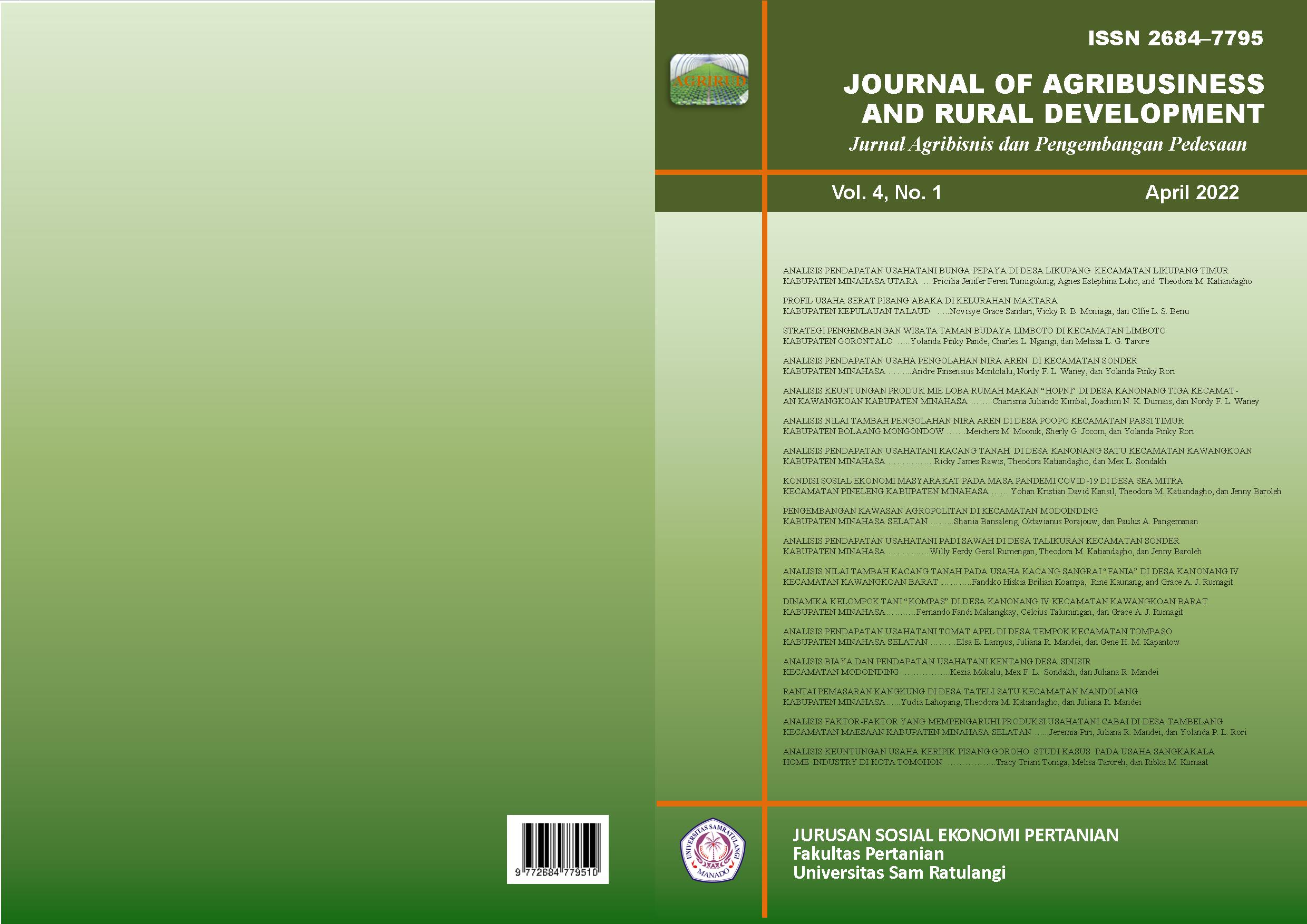ANALISIS PENDAPATAN USAHA PENGOLAHAN NIRA AREN DI KECAMATAN SONDER KABUPATEN MINAHASA (Farmer Income Analysis of Palm Sap Processing Business in Sonder Subdistrict Minahasa Regency)
DOI:
https://doi.org/10.35791/agrirud.v4i1.41248Keywords:
Income Analysis, Palm Sap Processing Business, Palm Sugar, CaptikusAbstract
The objective of this research is to analyze the business income of palm sap processing into palm sugar and captikus (captikus is the local name for alcoholic beverages from palm sap). The research was carried out in four villages, namely Rambunan, Sawangan, Tincep and Timbukar villages, Sonder sub-district, Minahasa Regency. The data used is data for March-May 2021. The data were analyzed descriptively using mathematical calculations and only calculated the costs incurred in cash/direct.
The research result showed that the ten captikus-making business units have 62 palm trees (Arenga pinnata, Merr) with a production of 420 liters of sap per tap and produce 195 liters of captikus. Ten business units producing palm sugar have 44 palm trees with sap production of 640 liters per tap and produce 160 kg of palm sugar. The price of captikus (alcohol content ± 40%) at the processing level is Rp. 37,500/liter, while the price of palm sugar is Rp. 22,000/kg. The revenue from the whole palm sugar maker business is Rp. 3.380.000,-/production and receipts off all captikus makers of Rp.7.312.500,-/production of the whole bussiness of palm sugar maker is Rp. 569,524. While the expenditure of the entire business of making captikus is Rp.293,302. The total income of palm sugar makers is Rp. 2,810,476,- per prdouction. The average income per business unit processing palm sap into palm sugar is Rp. 281,047,- per one- time production process, while the average income per besiness unit processing palm sap into captikus is Rp. 701,919,- per one time production process. The production of Captikus is carried out on average sixteen times a month, while the production of palm sugar is carried out on average twelve times a month. Processing palm sap into captikus provides greater income than processing palm sap into palm sugar.References
Akuba, R.H. 2004. Profil Aren. Pengembangan Tanaman Aren. Prosiding Seminar Na-sional Aren. Tondano. Balai Penelitian Tanaman Kelapa dan Palma Lain, 9 Juni. hlm.1-9.
Ditjen Perkebunan. 2004. Perkembangan aren di Indonesia. Prosiding Seminar Nasional Aren. Tondano, 9 Juni 2004. Balai Penelitian Tanaman Kelapa dan Palma Lain. hlm. 138-144.
Effendi, D.S. 2009. Aren, Sumber Energi Al-ternatif. Warta Penelitian dan Pengem-bangan Pertanian. Tahun 2009. 31(2):1-3.
Effendi, D.S. 2010. Prospek Pengembangan Tanaman Aren (Arenga pinnata Merr) Mendukung Kebutuhan Bioetanol di In-donesia. Perspektif Vol. 9 No. 1 / Juni 2010. Hal 36 – 46.
Rindengan, B dan E.Manaroinsong. 2009. Aren. Tanaman Perkebunan Penghasil Bahan Bakar Nabati (BBM). Pusat penelitian dan Pengembangan Perkebunan. hlm.1-22.






